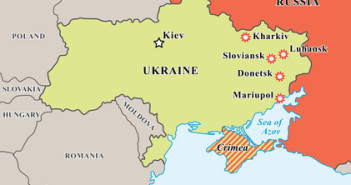Russia’s president Vladimir Putin announced that a ceasefire has been agreed on in Ukraine from February 15th.
One of the beneficiaries of the news is the Swiss National Bank: Thomas Jordan and his colleagues would like to see a weaker CHF, but wihtout having to intervene too much.
Russia – Ukraine Ceasefire
While the details will probably not make all sides happy: Ukraine is basically losing some of its territory to the pro-Russian rebels, even if officially the eastern territories remain part of the country.
And, it is still to be seen if the ceasefire holds: a past agreement, also agreed upon in Minsk back September did not last too long.
Nevertheless, this is good news after a lot of bloodshed in recent weeks and unfruitful negotiations so far. The efforts by French president Hollande and German Chancellor Merkel (which is busy with state elections in Hamburg as well as with the Greek crisis, and everything is connected) bore fruit.
Earlier, the advances of the rebels put pressure on the Ukrainians and the talk about arming Ukraine coming from Washington probably put pressure on Russia.
Swiss Franc
Since the SNB “bombed†markets by removing its 1.20 floor under EUR/CHF on January 15th, there have been reports about intervention and some rumors about a “soft floor†around 1.05. The dangers of deflation and a recession still make it worthwhile for the SNB to push the franc lower. However, it already knows that market pressure is too much.
One of the things that broke the SNB down, or at least led to the preliminary negative interest rate before January 15th was the inflow of money from Russia. In general, Switzerland serves as a “safe havenâ€Â in times of trouble.
And now, when there seems to be less trouble, there is motivation for money to flow out of Switzerland.
So, Putin contributed to a stronger franc, and now he is helping out in weakening it. At least for now.
By the way, the Russian Ruble is moving up, and this is good for Russia as well.
More: SNBomb – Reactions from 75 forex brokers
HEre is the EUR/CHF chart, which shows the pair leaving the 1.05 behind:




